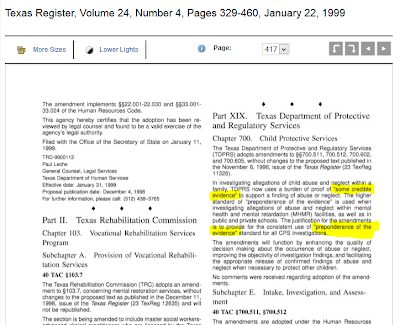An article appeared earlier this month on the My San Antonio page.
While you would think this should fall under the “Dah”
column you must first realize this is not part of the regular CPS program. This
program falls under “Prevention and Early Intervention.” A program that was supposed
to have moved out from under CPS to alongside when the “Flexible Response
System of Service Delivery” philosophy was introduced way back in 1997. Something
that NEVER happened.
You see, while Texas’ CPS system appears to be one of the
best among the states; that is only on paper. DFPS is not operated the way
their handbook indicates it was designed. The combination of huge turnovers in personnel
and the lack of accountability has resulted in thousands of Texas children
being over protected while thousands more are unprotected. The agency has lost
and continues to lack a solid knowledge base of what it actually takes to
protect children. The only way that will be corrected will be get them back
into the handbook and relearn the basics. They must stop using the unwritten “Best
Case Practices” their inexperienced supervisors are throwing at them. Our new
caseworkers are not being properly trained and our Texas children are paying
for it.
For example, let’s look at Investigations. The system was
designed around their conducting “Intake Assessments” not actual
investigations. After the initial contact, staffing with “Safety Services” is
to take place the next day and no later than 5 days into the case. Then it is
supposed to be a coordinated team effort between the FBSS and Investigations to
determine the overall safety of the family, where FBSS insures the home is safe
while Investigations takes care of things outside the home. Investigations is
supposed to be wrapped up no later than 60 days then they are to move on to
another case. This is the reason Investigation caseloads are spiraling out of
control.
Look at the Tamryn Klapheke case out of Abilene in August
2012. The investigator closed the case after 11 months with no indication that FBSS
was ever involved. While it is part of a FBSS caseworker’s job to check on a
child at least once every 30 days, it is not the job of investigations. This child
was not checked on over that extended period of time and it cost her life. Had
the investigator followed the handbook, Tamryn may have been still alive today.
While the program in this article sounds good, it is
currently only offered in the following counties: Cherokee County, Dallas
County, Ector County, Gregg County, Nueces County, Potter County, and the lower
Rio Grande Valley including Hidalgo and Willacy counties. So it is not readily
available to all Texas families.
Then you have to deal with the fear factor. Texas families
do not trust CPS. Very few are going to be willing to participate in programs
that are a child process of CPS. Family services MUST be made CPS’ sibling. Let’s
start using the system the way it was designed and not the way caseworkers want
it to work. TEXAS WAKE UP.
